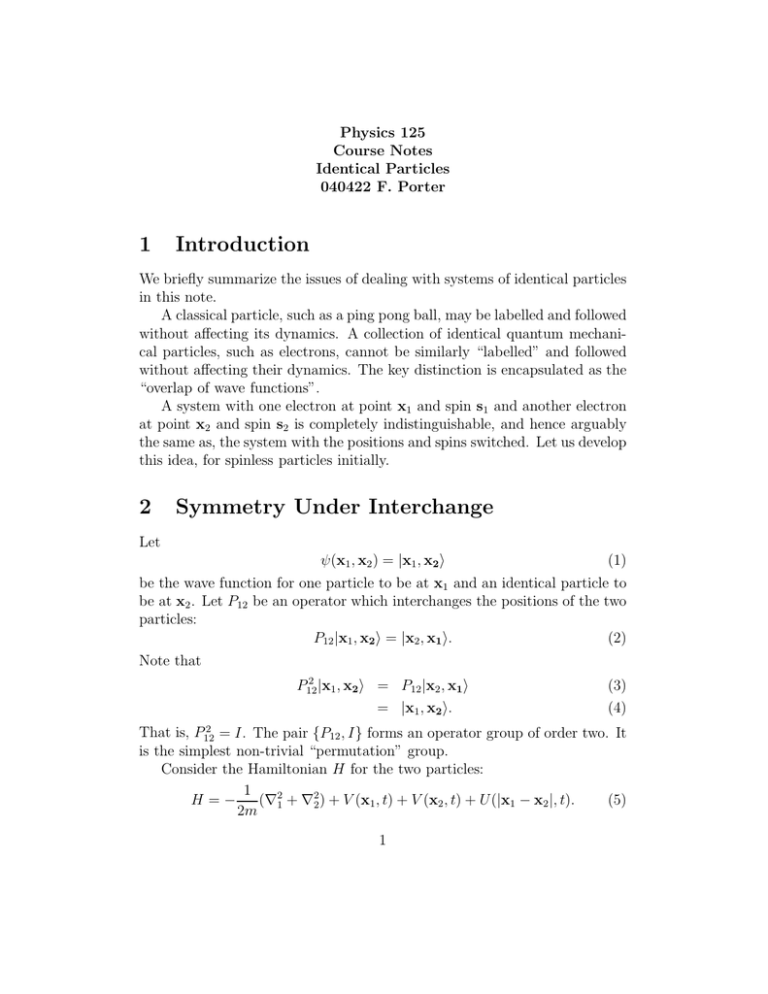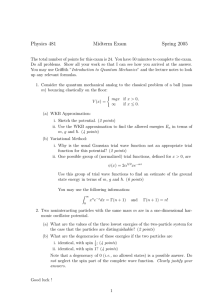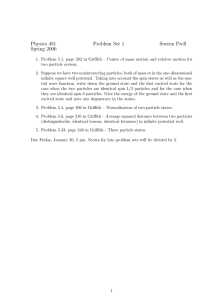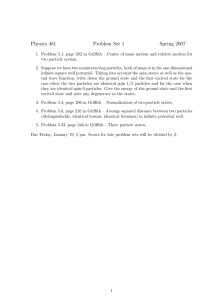1 Introduction 2 Symmetry Under Interchange
advertisement

Physics 125
Course Notes
Identical Particles
040422 F. Porter
1
Introduction
We briefly summarize the issues of dealing with systems of identical particles
in this note.
A classical particle, such as a ping pong ball, may be labelled and followed
without affecting its dynamics. A collection of identical quantum mechanical particles, such as electrons, cannot be similarly “labelled” and followed
without affecting their dynamics. The key distinction is encapsulated as the
“overlap of wave functions”.
A system with one electron at point x1 and spin s1 and another electron
at point x2 and spin s2 is completely indistinguishable, and hence arguably
the same as, the system with the positions and spins switched. Let us develop
this idea, for spinless particles initially.
2
Symmetry Under Interchange
Let
ψ(x1 , x2 ) = |x1 , x2 i
(1)
be the wave function for one particle to be at x1 and an identical particle to
be at x2 . Let P12 be an operator which interchanges the positions of the two
particles:
(2)
P12 |x1 , x2 i = |x2 , x1 i.
Note that
2
P12
|x1 , x2 i = P12 |x2 , x1 i
= |x1 , x2 i.
(3)
(4)
2
That is, P12
= I. The pair {P12 , I} forms an operator group of order two. It
is the simplest non-trivial “permutation” group.
Consider the Hamiltonian H for the two particles:
1
(∇2 + ∇22 ) + V (x1 , t) + V (x2 , t) + U (|x1 − x2 |, t).
H=−
(5)
2m 1
1
Note that I have written this in a form such that the interchange of the two
particles leaves the Hamiltonian unchanged. If this were not the case, then
the two particles would not be “identical”. Thus,
[P12 , H] = 0,
(6)
and we can find simultaneous eigenfunctions of P12 and H. What are the
eigenfunctions of P12 ? Let ψλ (x1 , x2 ) be an eigenstate:
P12 ψλ (x1 , x2 ) = λψλ (x1 , x2 ) = ψλ (x2 , x1 )
2
P12
ψλ (x1 , x2 ) = λ2 ψλ (x1 , x2 ) = ψλ (x1 , x2 ).
(7)
(8)
Thus, λ2 = 1, or λ = ±1.
If λ = +1, ψλ (x1 , x2 ) = ψλ (x2 , x1 ); the state is symmetric. If λ = −1,
ψλ (x1 , x2 ) = −ψλ (x2 , x1 ); the state is antisymmetric. Note that this implies
a degeneracy in the energy levels, since there are two states with the same
energy. This is referred to as an “exchange degeneracy”. However, it is experimentally observed that a pair of identical particles is always in an eigenstate
of P12 , and that eigenstate depends only on the kind of particle. From our
present perspective, this has the status of a fundamental principle. However,
in quantum field theory, it is a theorem – see, for example, Feynman’s 1986
Dirac Memorial Lecture, “The Reason for Antiparticles”, Cambridge University Press, or, for a more mathematical treatment, Streater and Wightman’s
book, “PCT Spin&Statistics and All That”.
To describe this observation, we need to add spin to the discussion. When
we add spin, P12 has the effect (by definition):
P12 |x1 , s1 ; x2 , s2 i = |x2 , s2 ; x1 , s1 i.
(9)
That is, the spin quantum numbers are also interchanged. Particles which
are symmetric under this interchange are called “bosons”. Particles which
are antisymmetric under this interchange are called “fermions”. It is found
that particles with integer spin (s=0,1,2,. . . ) are always bosons, and particles
with half-integer spin ( 12 , 32 , . . .) are always fermions. This is the celebrated
connection between spin and statistics.
An important consequence for fermions is the Pauli Exclusion Principle: Two identical fermions cannot be in the same quantum state. We may
“demonstrate” this as follows: Let {φk (x, s)|k = 1, 2, . . .} be an orthonormal
2
basis for a single particle state. Then a basis for a two particle identical
particle state is formed out of the product space:
{φk (x1 , s1 )} ⊗ {φk (x2 , s2 )}
(10)
Any two-particle wave function can be written in such a basis as:
ψ(x1 , s1 , x2 , s2 ) =
XX
j
Ajk φj (x1 , s1 )φk (x2 , s2 ).
(11)
k
If the two particles are in the same quantum state, then the coefficients must
be symmetric:
Ajk = Akj .
(12)
In that case,
−ψ(x2 , s2 , x1 , s1 ) = ψ(x1 , s1 , x2 , s2 )
XX
=
Ajk φj (x1 , s1 )φk (x2 , s2 )
=
=
j
k
j
k
j
k
XX
XX
(13)
(14)
Akj φj (x1 , s1 )φk (x2 , s2 )
(15)
Ajk φk (x1 , s1 )φj (x2 , s2 )
(16)
= ψ(x2 , s2 , x1 , s1 ).
(17)
Thus, ψ = −ψ, showing that the two particles cannot be in the same state.
The Pauli exclusion principle is crucial to atomic physics: once an energy
level in an atom is filled, any additional electrons must go into a different
level.
3
Example: Helium
Consider helium, with two electrons. The wave function of these two electrons
must be antisymmetric under interchange. We may use this to construct appropriate ground state quantum numbers. As validated in class discussion,
we assume that the spin-dependent forces (“fine structure”) may be regarded
as perturbations, and look for states with the smallest orbital angular momentum, and lowest radial quantum numbers. Thus, we look for a ground
3
Symmetric (S = 1)
| + +i
√1 (| + −i + | − +i
2
| − −i
Antisymmetric (S = 0)
√1 (|
2
+ −i − | − +i
state where both electrons have ` = 0 and both are in the lowest radial state
(principal quantum numbers n1 = n2 = 1):
ψ(x1 , x2 ) ∼ R(r1 , r2 , |x1 − x2 |),
(18)
where R(r1 , r2 , |x1 − x2 |) = R(r2 , r1 , |x1 − x2 |). That is, the spatial wave
function is symmetric under interchange: ψ(x1 , x2 ) = ψ(x2 , x1 ). For this
to be possible, the part of the wave function involving the spins must be
antisymmetric. Labelling the spin states by z-projections, i.e., for singleparticle states:
1
|m = + i = |+i,
2
1
|m = − i = |−i,
2
(19)
(20)
we have states for two electrons shown in the table above.
We conclude that the ground state of helium has S = 0, in order that
the overall wave function be antisymmetric with respect to interchange of
the two electrons. In spectroscopic (L-S) notation, the ground state is a 1 S0
state. We see that the ground state is, in fact, non-degenerate. There is only
one state, instead of the possible four spin arrangements otherwise.
4
Example: Isospin and Extended Pauli Principle
We consider an example in nuclear physics, which will lead us to formulating
a convenient “extended Pauli principle”. Consider the deuteron, made of a
proton and a neutron. We guess that this ground state of a proton and a
neutron is S-wave (` = 0), hence the spatial part of the wave function is
symmetric under neutron-proton interchange.
4
Experimentally, we observe no corresponding nn or pp bound states,
which we might expect form the charge independence of the nuclear force.
Hence, we suspect that the corresponding nn and pp states are forbidden
by the Pauli principle. From this inference, we shall deduce the spin of the
deuteron. Consider nn or pp in an ` = 0 state. If S = 1, the state is symmetric, hence not allowed. If S = 0 the state is antisymmetric, hence allowed.
As the deuteron does not have nn or pp analogs, we conclude that the spin
of the deuteron is S = 1.
With this example in mind, we can generalize our discussion of identical particles and obtain a useful bookkeeping tool. Thus, consider isotopic
spin, and regard the proton and neutron as identical particles with different
isotopic spin projections: The states of a nucleon, N are
1
1
|pi = |I = , I3 = i
2
2
1
1
|ni = |I = , I3 = − i.
2
2
(21)
(22)
Since the deuteron does not have nn and pp partners, it is an isotopic spin
singlet state (I(d) = 0):
1
|di = √ (|pni − |npi).
2
(23)
Regarding the p and n as states of identical fermions, we require that the
wave function be antisymmetric under interchange of all quantum numbers
(space, spin, and isotopic spin). A state of zero orbital angular momentum
and I = 0 must thus be even under spin interchange. Again the conclusion
is S(d) = 1.
Note that we haven’t actually introduced any new physical principle here,
just a bookkeeping device to arrive at the same result as before. Note that
the I = 1 combination, which is symmetric in isospin space, must have s = 0
(antisymmetric), if ` is even. We quote our bookkeeping device in the form
of an “Extended Pauli Principle”:
A state of two fermions, identical in the sense that they belong
to the same isotopic spin multiplet, must be antisymmetric under
interchange of all quantum numbers (space, spin, and isospin).
Likewise, we quote the corresponding “Extended Boson Principle”:
5
A state of two bosons, identical in the same sense, must be symmetric under interchange of all quantum numbers.
The identical particle symmetries have consequences also in scattering,
and also are manifest in the discussion of second quantization.
5
Exercises
1. Let us use the Pauli exclusion principle, and the combination of angular
momenta, to find the possible states which may arise when more than
one electron in an atom are in the same p-shell. Express your answers
for the allowed states in the spectroscopic notation: 2S+1 LJ , where S
is the total spin of the electrons under consideration, L is the total
orbital angular momentum, and J is the total angular momentum of
the electrons.
(a) List the possible states for 2 electrons in the same p-shell.
(b) List the possible states for 3 electrons in the same p-shell.
(c) List the possible states for 4 electrons in the same p-shell. Hint:
before you embark on something complicated for this part, think
a bit!
2. The pion (π) is a boson (with spin zero) with isotopic spin I = 1.
(a) Use our “extended “identical” boson symmetry principle to classify the allowed (I, J) values for a system of two pions. Here,
J refers to the relative angular momentum, and I to the total
isotopic spin, of the two pion state.
(b) Look up the experimental situation for particles which do and
don’t decay into two pions. [See, for example:
http://pdg.lbl.gov/2002/mxxx.pdf] Discuss what you find. Try to
resolve any puzzles, e.g., do you find particles which “ought” to
decay to two pions, but don’t? Do some decay to two pions when
they “shouldn’t”?
3. The magnetic dipole moment of the proton is:
µp = gp
6
e
sp ,
2mp
(24)
with a measured magnitude corresponding to a value for the gyromagnetic ratio of gp = 2 × (2.792847337 ± 0.000000029). We haven’t
studied the Dirac equation yet, but the prediction of the Dirac equation for a point spin-1/2 particle is g = 2. We may understand the
fact that the proton gyromagnetic ratio is not two as being due to its
compositeness: In the simple quark model, the proton is made of three
quarks, two “ups” (u), and a “down” (d). The quarks are supposed
to be point spin-1/2 particles, hence, their gyromagnetic ratios should
be gu = gd = 2 (up to higher order corrections, as in the case of the
electron). Let us see whether we can make sense out of the proton
magnetic moment.
The proton magnetic moment should be the sum of the magnetic moments of its constituents, and any moments due to their orbital motion
in the proton. The proton is the ground state baryon, so we assume
that the three quarks are bound together (by the strong interaction)
in a state with no orbital angular momentum. By Fermi statistics, the
two identical up quarks must have an overall odd wave function under
interchange of all quantum numbers. We must apply this with a bit of
care, since we are including “color” as one of these quantum numbers
here.
Let us look a little at the property of “color”. It is the strong interaction
analog of electric charge in the electromagnetic interaction. However,
instead of one fundamental dimension in charge, there are three color
directions, labelled as “red” (r), “blue” (b), and “green” (g). Unitary
transformations in this color space, up to overall phases, are described
by elements of the group SU (3), the group of unitary unimodular 3 ×
3 matrices. Just like combining spins, we may combine three colors
according to a Clebsch-Gordan series, with the result:
3 × 3 × 3 = 10 + 8 + 8 + 1.
(25)
We haven’t studied this group, so this decomposition into irreducible
representations of the product representation is probably new to you.
However, the essential aspect here is that there is a singlet in the decomposition. That is, it is possible to combine three colors in such a
way as to get a color-singlet state, i.e., a state with no net color charge.
These are the states of physical interest for our observed baryons, according to a postulate of the quark model.
7
(a) After some thought (perhaps involving raising and lowering operators along different directions in this color space), you could
probably convince yourself that the singlet state in the decomposition above must be antisymmetric under the interchange of
any two colors. Assuming this is the case, write down the color
portion of the proton wave function.
(b) Now that you know the color wave function of the quarks in the
proton, write down the spin wave function.
(c) Since the proton is uud and its isospin partner the neutron is
ddu, and mp ≈ mn , let us make the simplfying assumption that
mu = md . Given the measured value of gp , what does your model
give for mu ? Recall that the up quark has electric charge 2/3, and
the down quark has electric charge −1/3, in units of the positron
charge.
(d) Finally, use your results to predict the gyromagnetic moment of
the neutron, and compare with observation.
8






